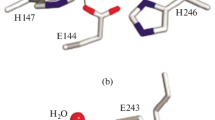Abstract
Low-temperature methane oxidation is one of the greatest challenges in energy research. Although methane monooxygenase (MMO) does this catalysis naturally, how to use this biocatalyst in a fuel cell environment where the electrons generated during the oxidation process is harvested and used for energy generation has not yet been investigated. A key requirement to use this enzyme in a fuel cell is wiring of the active site of the enzyme directly to the supporting electrode. In soluble MMO (sMMO), two cofactors, i.e., nicotinamide adenine di-nucleotide (NAD+) and flavin adenine dinucleotide (FAD) provide opportunities for direct attachment of the enzyme system to a supporting electrode. However, once modified to be compatible with a supporting metal electrode via FeS functionalization, how the two cofactors respond to complex binding phenomena is not yet understood. Using docking and molecular dynamic simulations, modified cofactors interactions with sMMO-reductase (sMMOR) were studied. Studies revealed that FAD modification with FeS did not interfere with binding phenomena. In fact, FeS introduction significantly improved the binding affinity of FAD and NAD+ on sMMOR. The simulations revealed a clear thermodynamically more favorable electron transport path for the enzyme system. This system can be used as a fuel cell and we can use FeS-modified-FAD as the anchoring molecule as opposed to using NAD+. The overall analysis suggests the strong possibility of building a fuel cell that could catalyze methane oxidation using sMMO as the anode biocatalyst.







Similar content being viewed by others
References
Xu J, Baase WA, Baldwin E, Matthews BW (1998) The response of T4 lysozyme to large-to-small substitutions within the core and its relation to the hydrophobic effect. Protein Sci 7(1):158–177
Murray EP, Tsai T, Barnett S (1999) A direct-methane fuel cell with a ceria-based anode. Nature 400(6745):649–651
Whittington DA, Rosenzweig AC, Frederick CA, Lippard SJ (2001) Xenon and halogenated alkanes track putative substrate binding cavities in the soluble methane monooxygenase hydroxylase. Biochemistry 40(12):3476–3482
Deeth RJ, Dalton H (1998) Methane activation by methane monooxygenase: free radicals, Fe-C bonding, substrate dependent pathways and the role of the regulatory protein. J Biol Inorg Chem 3(3):302–306
Chatwood LL, Müller J, Gross JD, Wagner G, Lippard SJ (2004) NMR structure of the flavin domain from soluble methane monooxygenase reductase from Methylococcus capsulatus (Bath). Biochemistry 43(38):11983–11991
Lee SJ, McCormick MS, Lippard SJ, Cho U-S (2013) Control of substrate access to the active site in methane monooxygenase. Nature 494(7437):380
Wang W, Iacob RE, Luoh RP, Engen JR, Lippard SJ (2014) Electron transfer control in soluble methane monooxygenase. J Am Chem Soc 136(27):9754–9762
Lin K-C, Chen S-M (2006) Reversible cyclic voltammetry of the NADH/NAD+ redox system on hybrid poly (luminol)/FAD film modified electrodes. J Electroanal Chem 589(1):52–59
Marafon E, Kubota LT, Gushikem Y (2009) FAD-modified SiO2/ZrO2/C ceramic electrode for electrocatalytic reduction of bromate and iodate. J Solid State Electrochem 13(3):377–383
Willner I, Heleg-Shabtai V, Blonder R, Katz E, Tao G, Bückmann AF, Heller A (1996) Electrical wiring of glucose oxidase by reconstitution of FAD-modified monolayers assembled onto au-electrodes. J Am Chem Soc 118(42):10321–10322
Golabi S, Zare HR (1999) Electrocatalytic oxidation of hydrazine at glassy carbon electrode modified with electrodeposited film derived from caffeic acid. Electroanalysis 11(17):1293–1300
Gorton L, Domı́ E (2002) Electrocatalytic oxidation of NAD (P) H at mediator-modified electrodes. Rev Mol Biotechnol 82(4):371–392
Karyakin AA, Ivanova YN, Karyakina EE (2003) Equilibrium (NAD+/NADH) potential on poly (neutral red) modified electrode. Electrochem Commun 5(8):677–680
Goodsell DS, Morris GM, Olson AJ (1996) Automated docking of flexible ligands: applications of AutoDock. J Mol Recogn 9(1):1–5
Norinder U, Österberg T (2001) Theoretical calculation and prediction of drug transport processes using simple parameters and partial least squares projections to latent structures (PLS) statistics. The use of electrotopological state indices. J Pharm Sci 90(8):1076–1085
O’Boyle NM, Banck M, James CA, Morley C, Vandermeersch T, Hutchison GR (2011) Open Babel: an open chemical toolbox. J Cheminform 3(1):33
Yagi K, Ozawa T (1960) Complex formation of apo-enzyme, coenzyme and substrate of d-amino acid oxidase: I. Kinetic analysis using indicators. Biochimica et biophysica Acta 42:381–387
Mahadevan A, Fernando T, Fernando S (2016) Iron–sulfur-based single molecular wires for enhancing charge transport in enzyme-based bioelectronic systems. Biosens Bioelectron 78:477–482
Mahadevan A, Gunawardena DA, Fernando S (2014) Biochemical and electrochemical perspectives of the anode of a microbial fuel cell technology and application of microbial fuel cells. InTech
Mahadevan A, Gunawardena DA, Karthikeyan R, Fernando S (2015) Potentiometric vs amperometric sensing of glycerol using glycerol dehydrogenase immobilized via layer-by-layer self-assembly. Microchim Acta 182(3–4):831–839
Nørskov JK, Rossmeisl J, Logadottir A, Lindqvist L, Kitchin JR, Bligaard T, Jonsson H (2004) Origin of the overpotential for oxygen reduction at a fuel-cell cathode. J Phys Chem B 108(46):17886–17892
Ghangrekar M, Shinde V (2007) Performance of membrane-less microbial fuel cell treating wastewater and effect of electrode distance and area on electricity production. Bioresour Technol 98(15):2879–2885
Sato F, Togo M, Islam MK, Matsue T, Kosuge J, Fukasaku N, Kurosawa S, Nishizawa M (2005) Enzyme-based glucose fuel cell using vitamin K 3-immobilized polymer as an electron mediator. Electrochem Commun 7(7):643–647
Park DH, Zeikus JG (2003) Improved fuel cell and electrode designs for producing electricity from microbial degradation. Biotechnol Bioeng 81(3):348–355
Palmore GTR, Bertschy H, Bergens SH, Whitesides GM (1998) A methanol/dioxygen biofuel cell that uses NAD+−dependent dehydrogenases as catalysts: application of an electro-enzymatic method to regenerate nicotinamide adenine dinucleotide at low overpotentials. J Electroanal Chem 443(1):155–161
Author information
Authors and Affiliations
Corresponding author
Additional information
Publisher’s Note
Springer Nature remains neutral with regard to jurisdictional claims in published maps and institutional affiliations.
Electronic supplementary material
ESM 1
(DOCX 77 kb)
Rights and permissions
About this article
Cite this article
Zhang, S., Karthikeyan, R. & Fernando, S.D. Evaluating apoenzyme–coenzyme–substrate interactions of methane monooxygenase with an engineered active site for electron harvesting: a computational study. J Mol Model 24, 347 (2018). https://doi.org/10.1007/s00894-018-3876-4
Received:
Accepted:
Published:
DOI: https://doi.org/10.1007/s00894-018-3876-4




